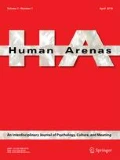Abstract
When Sorokin wrote the book Man and Society in Calamity, it was very clear what he meant by calamities—natural or man-made (war and revolution, famine, and pestilence)—and how these “monsters” transformed the normal flow of individuals’ lives. Indeed, since calamities occur in each and every age, they exert great influence on many aspects of everyday life: from forms of thought to acting, from social life to the cultural processes of society. Sorokin defines the “typical effects” that are repeated whenever disasters of the same type occur. The principle still holds today; after many years, the lexicon has changed, preferring the term disaster to calamity (now considered archaic, obsolete), but the effects of the events that we call disasters—on the thoughts, behavior, social organization, and cultural life of individuals—have not changed. And this is true despite the fact that scholars not always agree on which events should and/or could fall into this category. In contemporary society, we can hypothesize, even if briefly, the classification and the characteristics of disasters, since these elements differentiate the actions taken by the community affected and by those providing aid.
Similar content being viewed by others
References
Bonanno, G. A. (2004). Loss, trauma, and human resilience: have we understimated the human capacity to thrive after extremely eversive events? American Psychologist, 59, 20–28.
Bonanno, G. A., Galea, S., Bucciarelli, A., & Vlahov, D. (2006). Psychological resilience after disaster. Psychological Science, 17, 181–186.
Festinger, L. (1957). A theory of cognitive dissonance. Stanford: Stanford University Press.
Kreps, G. A. (2001). Disasters, sociology of. In N. J. Smelser & P. B. Baltes (Eds.), The international encyclopedia of the social and behavioral sciences (Vol. 6, pp. 3718–3721). Oxford: Elsevier.
Mangone, E. (2017). Social and cultural dynamics revisiting the Work of Pitirim A. Sorokin. Cham: Springer International Publisher AG.
Mangone, E. (2018). The reconstruction of a new system of needs after a post-war emergency. In S. Schliewe, N. Chaudhary, & G. Marsico (Eds.), Cultural psychology of intervention in the globalized world. Charlotte: Information Age Publishing Inc..
Manyena, S. B. (2006). The concept of resilience. Disasters, 30(4), 433–450.
Norris, F. H., Stevens, S. P., Pfefferbaum, B., Wyche, K. F., & Pfefferbaum, R. (2008). Community resilience as a metaphor, theory, set of capacities, and strategy for disaster readiness. American Journal of Community Psychology, 41, 127–150.
Phillips, B. D., Thomas, D. S. K., Fothergill, A., & Blinn-Pike, L. (Eds.). (2010). Social vulnerability to disaster. Boca Raton: CRC.
Piaget, J. (1972). L’épistémologie des relations interdisciplinaires. In OCDE (ed.), L’interdisciplinarité: problèmes d’enseignement et de recherche dans les universités. Paris: OCDE. Retrieved June 20, 2015, from http://www.fondationjeanpiaget.ch/fjp/site/textes/VE/jp72_epist_relat_interdis.pdf.
Sorokin, P. A. (1948). The reconstruction of humanity. Boston: The Bacon Press.
Sorokin, P. A. (1958). Integralism is my philosophy. In W. Burnett (Ed.), This is my Philosophy Twenty of the World’s Outstanding Thinkers reveal the Deepest Meaning they have found in Life (pp. 180–189). London: George Allen & Unwin Ltd..
Sorokin, P. A. (2010). Man and society in calamity. Brunswick (U.S.A.) and London (U.K.): Transaction Publishers (orig. ed. 1942).
van den Eynde, J., & Veno, A. (1999). Coping with disastrous events: an empowering model of community healing. In R. Gist & B. Lubin (Eds.), Response to disaster: psychosocial community and ecological approaches (pp. 167–192). Philadelphia: Brunner/Mazel.
Author information
Authors and Affiliations
Corresponding author
Rights and permissions
About this article
Cite this article
Mangone, E. From Calamities to Disasters: Pitirim Aleksandrovič Sorokin’s Insights. Hu Arenas 1, 79–85 (2018). https://doi.org/10.1007/s42087-018-0001-2
Received:
Revised:
Accepted:
Published:
Issue Date:
DOI: https://doi.org/10.1007/s42087-018-0001-2




